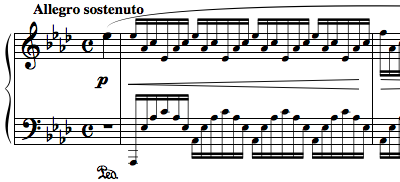
Étude Op. 25, No. 1 (Chopin)
Encyclopedia

Frédéric Chopin
Frédéric François Chopin was a Polish composer and virtuoso pianist. He is considered one of the great masters of Romantic music and has been called "the poet of the piano"....
in 1836, and published in 1837. Its romanticized names are "Aeolian Harp," for Schumann's description of it, and "The Shepherd Boy," for Chopin's advice to a pupil to picture a shepherd boy refuging in a grotto to avoid a storm playing the melody on his flute. This work consists entirely of rapid arpeggios and harmonic modulations based on A-flat major.
Robert Schumann
Robert Schumann
Robert Schumann, sometimes known as Robert Alexander Schumann, was a German composer, aesthete and influential music critic. He is regarded as one of the greatest and most representative composers of the Romantic era....
famously praised this work in a dissertation on the Études. Stating that the arpeggios were "fantastic", and the melody "wondrous", Schumann coined the alternate name "Aeolian Harp
Aeolian harp
An aeolian harp is a musical instrument that is "played" by the wind. It is named for Aeolus, the ancient Greek god of the wind. The traditional aeolian harp is essentially a wooden box including a sounding board, with strings stretched lengthwise across two bridges...
" for this étude.
Structure
This étude comprises a right-hand melody and supportive bass line, the accompaniment consisting of broken chords, provided by the inner voices of both hands, usually in semiquaver-tupletTuplet
In music a tuplet is "any rhythm that involves dividing the beat into a different number of equal subdivisions from that usually permitted by the...
s. The left hand introduces polyrhythyms
Polyrhythm
Polyrhythm is the simultaneous sounding of two or more independent rhythms.Polyrhythm in general is a nonspecific term for the simultaneous occurrence of two or more conflicting rhythms, of which cross-rhythm is a specific and definable subset.—Novotney Polyrhythms can be distinguished from...
from time to time. The principal melody is presented by the right hand on the first note of each group of sextuplets, with occasional counter-melodies provided by the inner voices.
The distinctive theme is presented in A-flat major. Through metamorphic modulations to closely related keys, it eventually arrives at a brief episode in the remote key of A major, but culminates with an intense climax in the home key, and a momentary reference to the original thematic material, which flows easily into the coda
Coda (music)
Coda is a term used in music in a number of different senses, primarily to designate a passage that brings a piece to an end. Technically, it is an expanded cadence...
.
Technique
As a technical work, this piece requires very little dexterity and velocity, compared to the other etudes. The inner voice figures consist of repeated figures of arpeggiated chords. One difficulty this étude presents is the voicing of the inner counter-melodies. Schumann once commented on Chopin's subtle emphasis on certain melodies throughout this piece.External links
- Analysis of Chopin Etudes at Chopin: the poet of the piano
- Sheet music available in .pdf or LilyPond format, from Mutopia.

